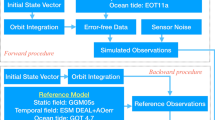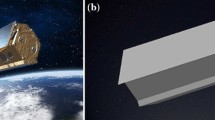Abstract
The goal of this contribution is to focus on improving the quality of gravity field models in the form of spherical harmonic representation via alternative configuration scenarios applied in future gravimetric satellite missions. We performed full-scale simulations of various mission scenarios within the frame work of the German joint research project “Concepts for future gravity field satellite missions” as part of the Geotechnologies Program, funded by the German Federal Ministry of Education and Research and the German Research Foundation. In contrast to most previous simulation studies including our own previous work, we extended the simulated time span from one to three consecutive months to improve the robustness of the assessed performance. New is that we performed simulations for seven dedicated satellite configurations in addition to the GRACE scenario, serving as a reference baseline. These scenarios include a “GRACE Follow-on” mission (with some modifications to the currently implemented GRACE-FO mission), and an in-line “Bender” mission, in addition to five mission scenarios that include additional cross-track and radial information. Our results clearly confirm the benefit of radial and cross-track measurement information compared to the GRACE along-track observable: the gravity fields recovered from the related alternative mission scenarios are superior in terms of error level and error isotropy. In fact, one of our main findings is that although the noise levels achievable with the particular configurations do vary between the simulated months, their order of performance remains the same. Our findings show also that the advanced pendulums provide the best performance of the investigated single formations, however an accuracy reduced by about 2–4 times in the important long-wavelength part of the spectrum (for spherical harmonic degrees \({<}50\)), compared to the Bender mission, can be observed. Concerning state-of-the-art mission constraints, in particular the severe restriction of heterodyne lasers on maximum range-rates, only the moderate Pendulum and the Bender-mission are beneficial options, of course in addition to GRACE and GRACE-FO. Furthermore, a Bender-type constellation would result in the most accurate gravity field solution by a factor of about 12 at long wavelengths (up to degree/order 40) and by a factor of about 200 at short wavelengths (up to degree/order 120) compared to the present GRACE solution. Finally, we suggest the Pendulum and the Bender missions as candidate mission configurations depending on the available budget and technological progress.






Similar content being viewed by others
References
Anselmi A, Cesare S, Visser P, Van Dam T, Sneeuw N, Gruber T, Altes B, Christophe B, Cossu F, Ditmar P, Murboeck M, Parisch M, Renard M, Reubelt T, Sechi G, Texieira Da Encarnacao JG (2011) Assessment of a next generation gravity mission to monitor the variations of Earth’s gravity field. ESA Contract No. 22643/09/NL/AF, Executive Summary, Thales Alenia Space report SD-RP-AI-0721, March 2011
Bender P, Wiese D, Nerem R (2008) A possible dual-GRACE mission with 90 degree and 63 degree inclination orbits, paper presented at third international symposium on formation flying, Eur. Space Agency, Noordwijk, Netherlands, 23–25 April
Christophe B, Marque J-P, Foulon B (2010) Accelerometers for the ESA GOCE Mission: one year of in-orbit results. Presentation at EGU 2010, Vienna. ESA GOCE website. http://earth.esa.int/pub/ESA_DOC/GOCE/Accelerometers%20for%20the%20ESA%20GOCE%20Mission%20-%20one%20year%20of%20in-orbit%20results.pdf. Accessed on 24 September 2012
Coddington I, Swann WC, Nenadovic L, Newbury NR (2009) Rapid and precise absolute distance measurements at long range. Nature Photonics 3:351–356. doi:10.1038/nphoton.2009.94
Elsaka B (2010) Simulated satellite formation flights for detecting the temporal variations of the earth’s gravity field. University of Bonn, Germany, Ph.D Dissertation
Elsaka B (2014) Sub-month gravity field recovery from simulated multi-GRACE mission type. Acta Geophys. doi:10.2478/s-11600-013-0170-9 (in press)
Elsaka B, Kusche J, Ilk KH (2012) Recovery of the earth’s gravity field from formation-flying satellites: temporal aliasing issues. Adv Space Res 50:1534–1552. doi:10.1016/j.asr.2012.07.016
Flechtner F, Watkins M, Morton P, Webb F (2013) Status of the GRACE Follow-on Mission. Proceedings of the International Association of Geodesy Symposia Gravity, Geoid and Height System (GGHS2012), 9.-11.10.2012, Venice, Italy, IAGS-D-12-00141 (accepted)
Förste C, Schmidt R, Stubenvoll R, Flechtner F, Meyer U, Koenig R, Neu-mayer H, Biancale R, Lemoine J, Bruinsma S, Loyer S, Barthelmes F, Esselborn S (2008) The GeoForschungsZentrum Potsdam/Groupe de Recherche de Ge-odesie Spatiale satellite-only and combined gravity field models: EIGEN-GL04S1 and EIGEN-GL04C. J Geod 82(6):331–346. doi:10.1007/s00190-007-0183-8
Gerlach C, Flury J, Frommknecht B, Flechtner F, Rummel R (2005) GRACE performance study and sensor analysis. In: Proceedings of the Joint CHAMP/GRACE Science Meeting, GeoForschungsZentrum Potsdam, July 6–8, 2004, p. 6.1, http://www-app2.gfz-potsdam.de/pb1/JCG/Gerlach-etal_jcg.pdf
Gruber T, Bamber J, Bierkens M, Dobslaw H, Murböck M, Thomas M, van Beek L, van Dam T, Vermeersen LLA, Visser P (2011) Simulation of the time-variable gravity field by means of coupled geophysical models. Earth System Science Data 3:19–35. doi:10.5194/essd-3-19-2011
Hedin A (1987) MSIS-86 Thermospheric Model. JGR 92(A5):4649–4662. doi:10.1029/JA092iA05p04649
Iran Pour S, Reubelt T, Sneeuw N (2013) Quality assessment of sub-Nyquist recovery from future gravity satellite missions. J Adv Space Res 52(5):916–929
Knocke P, Ries J, Tapley B (1988) Earth radiation pressure effects on satellites. In: Proceedings of the AIAA/AAS astrodynamics specialist conference, Washington DC, pp 577–586
Koch KR (1997) Parameterschätzung und Hypothesentests. Dümmler, Bonn
Koch KR, Kusche J (2001) Regularization of geopotential determination from satellite data by variance components. J Geod 76(5):641–652
Lemoine F, Kenyon S, Factor J, Trimmer R, Pavlis N, Cox C, Klos-ko S, Luthcke S, Torrence M, Wang Y, Williamson R, Pavlis E, Rapp R, Olson T (1998) the development of the joint NASA GSFC and the Na-tional Imagery and Mappping Agency (NIMA) Geopotential Model EGM96. NASA/TP-1998-206861, July, 1998
Mayer-Gürr T, Ilk K-H, Eicker A, Feuchtinger M (2005) ITG-CHAMP01: a CHAMP Gravitiy Field Model from short kinematical arcs of a one-year observation period. J Geod 78:462–480
Mayer-Gürr T (2006) Gravitationsfeldbestimmung aus der Analyse kurzer Bahnbögen am Beispiel der Satellitenmissionen CHAMP und GRACE. University of Bonn, Germany, Ph.D Dissertation
NG2 Team (2011) Assessment of a next generation gravity mission to monitor the variations of earth’s gravity field. Final Report, ESTEC Contract No.: 22672/09/NL/AF. Doc. No.: NG2-ASG-FR, Issue 1, 10 Oct. 2011
Ray R (2008) GOT4.7 (private communication). Extension of Ray R (1999) A global ocean tide model from Topex/Poseidon altimetry GOT99.2. NASA Tech Memo 209478, Sept. 1999
Reubelt T, Sneeuw N, Iran Pour S (2011) Quick-look gravity field analysis of formation scenarios selection. In: Münch U, Dransch W (eds) Observation of the system earth from space, GEOTECHNOLOGIEN Science Report No. 17, Status Seminar, 4 (October 2010) Rheinische Friedrich Wilhelms Universität Bonn. Koordinierungsbüro GEOTECHNOLOGIEN, Potsdam
Reubelt T, Sneeuw N, Iran Pour S, Hirth M, Fichter W, Müller J, Brieden Ph, Flechtner F, Raimondo JC, Kusche J, Elsaka B, Gruber T, Pail R, Murböck M, Doll B, Sand R, Wang X, Klein V, Lezius M, Danzmann K, Heinzel G, Sheard B, Rasel E, Gilowski M, Schubert C, Schäfer W, Rathke A, Dittus H, Pelivan I (2014) Future gravity field satellite missions. In: Flechtner F, Sneeuw N, Schuh W-D (eds) Observation of the system earth from space–CHAMP, GRACE, GOCE and future missions. GEOTECHNOLOGIEN Science Report No. 20, Series “Advanced Technologies in Earth Sciences”. Springer, Berlin, ISBN 978-3-642-32134-4 (in press)
Savcenko R, Bosch W (2008) EOT08a–empirical ocean tide model from multi-mission satellite altimetry. Report No. 81, Deutsches Geodätisches Forschung-sinstitut (DGFI), München
Sharifi M, Sneeuw N, Keller W (2007) Gravity Recovery capability of four generic satellite formations. In: Kilicoglu A, Forsberg R (eds) Gravity Field of the Earth. General Command of Mapping, ISSN 1300–5790. Special issue, vol 18, pp 211–216
Sheard B, Heinzel G, Danzmann K, Shaddock D, Klipstein W, Folkner W (2012) Intersatellite laser ranging instrument for the GRACE follow-on mission. J Geod 86(12):1083
Sneeuw N, Sharifi M, Keller W (2008) Gravity recovery from formation flight missions. Xu P, Liu J, Athanasios D (eds) VI Hotine-Marussi symposium on theoretical and computational geodesy, vol 132. Springer, Berlin, pp 29–34
Standish EM (1998) JPL planetary and lunar ephemerides, “DE405/LE405”. IOM 312.F-98-048, August 26 1998
Visser P, Sneeuw N, Reubelt T, Losch M, van Dam T (2010) Space-borne gravimetric satellite constellations and ocean tides: aliasing effects. Geophys J Int 181:789–805
Wagner C, McAdoo D, Klokočník J, Kostelecký J (2006) Degradation of geo-potential recovery from short repeat-cycle orbits: application to GRACE monthly fields. J Geod 80(2):94–103
Wiese D, Folkner W, Nerem R (2009) Alternative mission architectures for a gravity recovery satellite mission. J Geod 83:569–581. doi:10.1007/s00190-008-0274-1
Wiese D, Nerem R, Han S.-C (2011) Expected improvements in determining continental hydrology, ice mass variations, ocean bottom pressure signals, and earthquakes using two pairs of dedicated satellites for temporal gravity recovery. J Geophys Res 116(B11):405. doi:10.1029/2011JB008375
Wiese D, Nerem R, Lemoine F (2012) Design considerations for a dedicated gravity recovery satellite mission consisting of two pairs of satellites. J Geod 86:81–98. doi:10.1007/s00190-011-0493-8
Acknowledgments
The authors would like to thank the reviewers for their valuable comments. We gratefully acknowledge Dr. Pavel Ditmar, the Editor, for his valuable comments and corrections to improve this manuscript. Additionally, the financial support of the German Federal Ministry for Education and Research (BMBF) and the German Research Foundation (DFG) within the frame work of the German joint research project “Concepts for future gravity field satellite missions” as part of the Geotechnologies Program (grant 03G0729) is acknowledged.
Author information
Authors and Affiliations
Corresponding author
Rights and permissions
About this article
Cite this article
Elsaka, B., Raimondo, JC., Brieden, P. et al. Comparing seven candidate mission configurations for temporal gravity field retrieval through full-scale numerical simulation. J Geod 88, 31–43 (2014). https://doi.org/10.1007/s00190-013-0665-9
Received:
Accepted:
Published:
Issue Date:
DOI: https://doi.org/10.1007/s00190-013-0665-9




